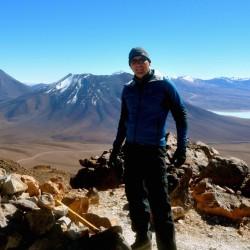Here at The Adventure Blog we routinely share stories of the impact of climate change and warming temperatures on our planet. For instance, just recently we wrote about how thawing tundra in Denali National Park is causing the only road there to sink dramatically and we've had several articles on shifting conditions in Greenland. But even those stories may not have prepared us for the news coming out of the Pacific Northwest in the U.S., where a historically hot summer is directly impacting the outdoor activities we love.
A few days back, Outside Online posted a story about the current state of mountaineering in the Cascade Range, where warmer weather has decimated the snowpack. It has gotten to bad in fact, that some of the world's top guiding companies have haled climbing on Mt. Rainier, even though they would traditionally be climbing for several more weeks yet. Conditions are so bad there however, that the iconic peak has now been declared by many to be unsafe.

Mt. Rainier Climbing Season Halted
According to Outside, Rainier Mountaineering (RMI), Alpine Ascents International (AAI), and International Mountain Guides (IMG) have all announced that they have cancelled the remaining climbs scheduled on Rainier for 2021. Considering all three outfitters are usually booked solid every day from the beginning of May through the end of September, this is a pretty surprising turn of events. But because conditions have changed so dramatically on the mountain, these companies-who collectively have been operating for more than 120 years-have decided to pull the plug.
What led to this decision? As noted, the extremely warm temperatures in the PNW have caused the snow to retreat at a rate that has never been seen before. For the first time ever, Mt. Baker has no snow on its summit at all and Mt. Rainier-the most glaciated peak in the lower 48-has only a fraction of its normal levels. Further south, Mt. Shasta is experiencing similar loss of snow and ice, leaving it almost completely bare as well.
On Rainier, the decision to halt operations came when the well-traveled Disappointment Cleaver route melted completely. Without any snow and ice to hold rock and dirt in place, the climbers were subjected to a steady flow of falling debris. It has gotten to the point where the level of risk is simply unacceptable for the guide services and most independent climbers too.

Hottest Year on Record
In case you're thinking that perhaps the mountains were in bad shape before the summer even got started, Outside is quick to dispel this idea. In the article linked above, the author reports that the Cascade Range received 131% of its normal amount of snow last year. That means that by the time the spring arrived, bringing warmer temperatures wit it, there was actually considerably more snowpack than normal.
In June, temperatures climbed to incredibly high levels and stayed there for days at a time. Those warmer conditions reduced the number of high-altitude summer snowfalls too, bringing rain to the mountains instead. As we all know, rain tends to eat snow at a rapid pace, which is part of the reason the summit of Mt. Baker is currently bare. At one point, it rained for three days on the summit, something that was practically unheard of in the past.
During that same June heatwave, temperatures at the famous Muir Camp on Mt. Rainier jumped to as high as 66ºF (19ºC). Reports indicate that 30% of the snow and ice disappeared during that timeframe alone. Successive heat waves that followed continued the trend, resulting in what is now recognized as the hottest year on record. Previously, that distinction went to 1936, the year that produced the famed Dust Bowl.
The Future of Climbing Mt. Rainier
In the Outside article, RMI guide Dave Hahn is quoted as saying that he "can't think of something like this happening before." Considering Hahn has been guiding for more than 35 years, that says a lot. But the question is, what does this mean for the future of climbing on Mt. Rainier and beyond?
Warming temperatures will continue to have an impact on our favorite alpine settings, many of which have been seeing glaciers retreated at a rapid pace for years. As that snow and ice disappear, climbing will become inherently more dangerous. As noted, a frozen mountain is a safer mountain in terms of keeping loose scree in place. Falling rock is the bane of any climber's existence, causing injuries and death.
Snow and ice also provide better traction than walking in crampons over bare rock. Should conditions change on some of the more technically difficult peaks, the summits could become much more difficult to reach as well. This isn't likely to cause the best alpinists in the world to halt their high-altitude pursuits, but future expeditions will have to prepare and plan different. They'll also have to be willing to accept more risks.
Is 2021 a sign of things to come when it comes climbing Mt. Rainier and other peaks in the Pacific North West? In all likelihood, without question. But how long before shifting environmental conditions have a more dramatic impact on the Himalaya, the Andes, or Patagonia remains to be seen. Unfortunately, at this point it seems likely it is only a matter of time. And modern mountaineering will have to shift to contend with it.



